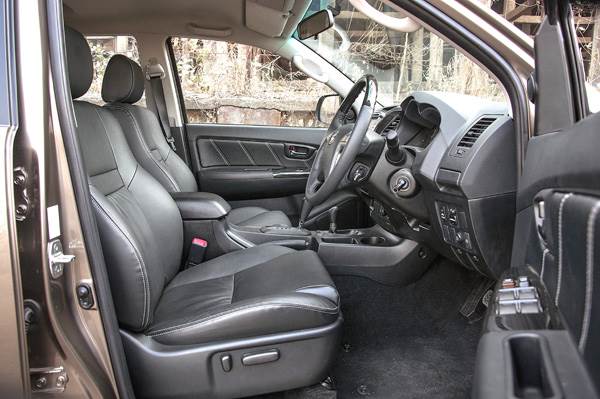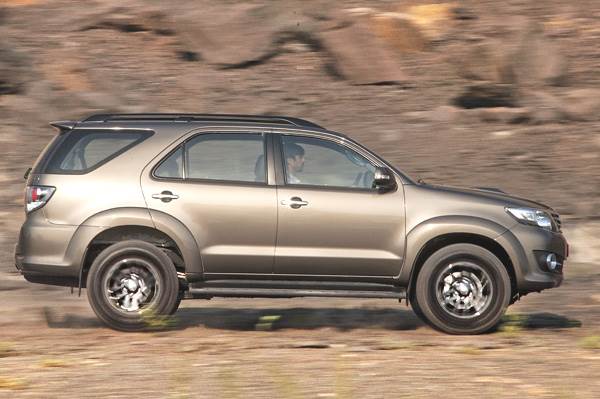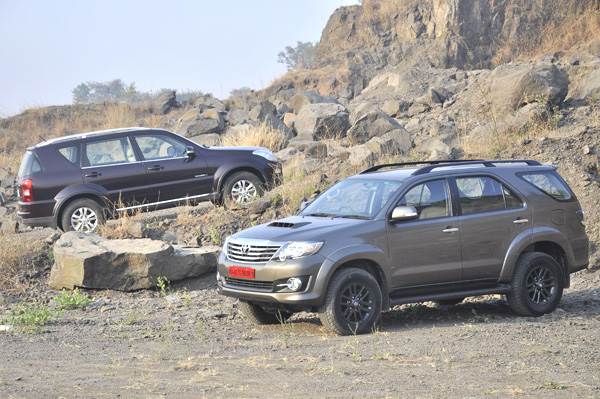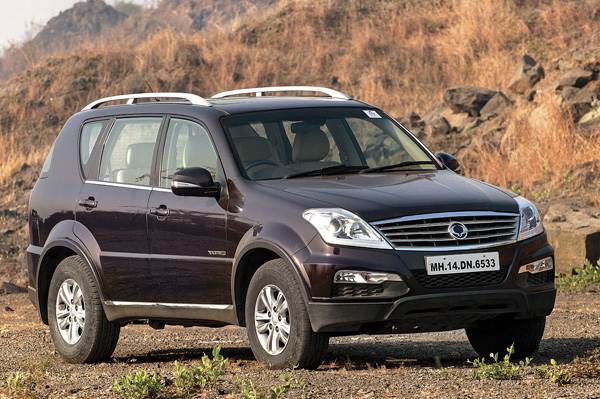Old-fashioned SUVs are going out of style in the western world. Both heavy and inefficient, they are frowned upon for their bulk and resulting poor efficiency. This is especially true if they are primarily used on tarmac, where their special skills are seldom given a workout. But here in India, full-fat SUVs still have plenty of appeal. They are big, flashy, can tackle our ‘bombed out’ roads without batting an eyelid, and can even seat seven; what’s not to like? Used more as tough and semi-affordable pseudo luxury cars, big SUVs in India have lots of fans.
Toyota’s Fortuner has always sat at the top of its class. Introduced in 2009, it came with only a manual gearbox for years. Toyota did launch an automatic version in early 2012, but that was mated to the two-wheel-drive option. Now, the Japanese company has finally broadened the appeal of its much loved SUV by giving the proper four-wheel-drive version the same automatic gearbox as well. But it’s not alone. Mahindra-owned SsangYong’s Rexton is also similarly specified. Based on the first-generation Mercedes-Benz M-class or W163, the Rexton, like the Toyota has full-time four-wheel drive and a five-speed automatic gearbox. But is it good enough to take on the Fortuner?
Built tough
Body-on-frame SUVs must look bulky and imposing; it’s part of their DNA. In addition, they must look sophisticated enough to pass muster as luxury vehicles. Of the two, the Fortuner has a slightly harder edge to its design. The snarling nose is seriously aggressive, the nostril-like bonnet scoop and squinting headlights combine to give it an angry scowl. What makes it even more imposing is the fact that it sits a good half foot higher off the ground than its rivals. New bits on the exterior of the 4X4 automatic Fortuner include blacked out parts like the alloys, smoked headlights and tail-lights for a more ‘custom’ look. But does it work?

The lower-slung Rexton has softer lines and looks more relaxed, but it simply doesn’t have the Fortuner’s imposing road presence. Designed by Giorgietto Giugiaro, the Rexton isn’t one of the Italian design guru’s better jobs.
Under the skin, these SUVs are similar up to a point. Both cars are built using a body-on-frame construction and both cars come with full-time four-wheel drive, but it’s the Toyota that has more serious kit like a low-range gearbox and lockable differentials. As a result, the Fortuner is also the heavier of the two. The SsangYong, on the other hand, gets hill descent control. The Fortuner also comes with a less powerful engine; it makes 168bhp as against the Rexton’s 184bhp. Max torque from the Fortuner’s larger engine, however, comes in earlier, good for driving off-road, and the Toyota also uses clever gearing to help compensate.
Inside Track
The new Fortuner gets a few changes on the inside. Not enough to fundamentally change things, but enough to lift the cabin ambience a bit. Now finished in black, with double stitched black leather seats, the new interiors look a bit sportier. The Innova-based steering wheel, dials and air-con controls, however, are still carried over, and the touchscreen audio/navigation system still looks like an aftermarket fitting. The design of the dash though is much nicer than that of the really basic SsangYong. The Rexton’s dials and steering wheel look particularly old-fashioned and there are some really poorly built plastic bits like the stalks and gear lever. And to add to its woes, its screen is even more difficult to operate than that of the Toyota.

Where the Rexton strikes back is seat comfort. While the Fortuner’s front seats are hard and need adjustment before you get comfortable, the Rexton’s softer, more luxurious seats are much comfier. This is true of the rear seat as well, and the bench on the second row is the wider of the two, meaning seating three abreast is more comfortable.

The Fortuner, however, has more legroom in the second row and the bench can also be moved forward and back for greater flexibility. It also has the better third-row seats. Yes, it is a bit more difficult clambering into the back, past the second-row seat, as the floor of the Fortuner is a good half foot higher than the Rexton’s, but at the end of it all, there’s still a usable seat here. It’s not comfortable though; you have to sit low, and there is only barely enough space for your feet. But at least you are not sitting at the level of the floor, as in the SsangYong which is much less comfortable. In addition, the Toyota’s third-row seats split for added flexibility.
The Rexton is the better equipped of the two. It comes with Electronic Stability Program (ESP), Active Rollover Protection, a sunroof and driver seat position memory, all of which except the ESP, are missing on the Fortuner. The Toyota does get a reversing camera though, absent on the Rexton.
Automatic performers
Proper, middle-of-the-road, four-wheel-drive SUVs use heavy ladder chassis, weighty transfer cases and bulky suspension systems that are strong enough to handle World War III. As a result, they waste plenty of energy when they take off from rest; this is very evident from behind the wheel of both cars. Take off from rest in the Fortuner and you can feel the slurring torque converter chiming in. As a result, the automatic feels a bit more sluggish off the line than the manual gearbox-equipped car, the auto ’box sapping a bit of the power. It does feel much more relaxed when cruising at between 2,000 and 3,000rpm, the strong mid-range of the big 3.0-litre diesel engine helping considerably here. And the gearbox is reasonably quick to downshift too. What also makes driving the Fortuner nicer is that there isn’t any discernable turbo lag, meaning it is quick to respond and snaps up overtaking opportunities nicely. The Fortuner 4X4 auto’s 0-100kph time of 12.32 seconds feels reasonably quick.

The Rexton’s smaller-capacity five-cylinder diesel is much smoother and feels considerably quicker. The five-cylinder engine likes to rev and the spread-out gears help keep it in the powerband for longer. So performance is strong, 0-100kph taking only 10.6 seconds in contrast. What spoils it for the Rexton, however, is the fact that there is a fair amount of turbo lag and the gearbox is dim witted and slow. This is evident from the considerable delay you experience when you take off from rest. And the delay in going up and down the gearbox is a bit too much as well. So, while the engine pulls well, the pauses in between are quite frustrating. You can shift gears manually, but the tiny button on the gear lever is a bit fiddly.
Moving manners
The Fortuner rides high off the ground, and that means Toyota has had to stiffen the suspension to keep body roll in check. Low-speed ride, as a result, is a bit lumpy, as on many body-on-frame SUVs, and there’s also a bit of shuddering from all the unsprung mass being thrown around if the surface becomes worse. The ride, however, improves as you go faster and the suspension does a good job over really bad patches.
The lower slung Rexton is softer sprung. And that works well at low speeds. The suspension is silent and absorbent and this means ride is decent. In addition, the smooth, light steering also makes driving this car around at city speeds pretty stress-free. But up the speed and the soft Rexton bobs around uncomfortably and doesn’t give you the sense of control the as Toyota, which rides far better at higher speeds.
In fact, the Fortuner 4X4 is overall much nicer to drive. The weighty steering delivers more feel and the Toyota doesn’t roll as uncontrollably as the Rexton, which in contrast floats nervously, the light steering delivering almost no feel. And so, it’s not as sure-footed as the Fortuner.

The Rexton’s driving dynamics are its weak link and its clearly not as sure-footed as the Toyota, despite running on more suitable road-biased tyres.
The brakes on both cars are weak though. They work fine for regular driving, but don’t quite deliver the stopping power needed when you need to stop in a hurry. Add a full complement of passengers and you can feel that the brakes aren’t quite adequate.
The Fortuner is also better off-road. Its higher stance gives it an edge initially and then when things get really tough, it can up its game unlike the Rexton. Its full-time 4x4 system is equipped with a manually selectable low-ratio gearbox and you can even lock the diffs when you encounter sand, slush and other low-grip conditions.
Driving off-road, the Fortuner feels more adept and hauls you out of sticky situations far more easily than the Rexton, whose road-biased tyres and more vulnerable ramp-break over angle can bog you down more easily.
Fact of the matter
The SsangYong Rexton may not be the most successful car in its class, but it has a lot going for it. It feels smooth, refined and comfortable on the inside and the five-cylinder engine delivers plenty of performance. What the Rexton RX7 also does extremely well is play the value card; you really do get a lot of kit for the money. The Fortuner, however, noses ahead of it because it delivers a stronger all-round performance. To begin with, it is nicer to drive. The engine and gearbox are more responsive, it feels more surefooted at speed and it is much more accomplished off road. Then, there’s more space on the second row, the third-row seats are actually useable and here is one Japanese car that feels as tough as nails. Yes, it is Rs 3.33 lakh more expensive, and that is a bit of a head scratcher, but factor in the Toyota versus SsangYong advantage on re-sale, and you should be more than covered. Not interested in re-sale? How about the fact that it is more than likely to last you the better part of a decade? That should settle it then.






Comments
Member Login
Personal Details
No comments yet. Be the first to comment.